 W
WCarnatic music, known as Karnāṭaka saṃgīta or Karnāṭaka saṅgītam in the South Indian languages, is a system of music commonly associated with South India, including the modern Indian states of Karnataka, Andhra Pradesh, Telangana, Kerala and Tamil Nadu, and Sri Lanka. It is one of two main subgenres of Indian classical music that evolved from ancient Sanatana dharma sciences and traditions, the other subgenre being Hindustani music, which emerged as a distinct form because of Persian or Islamic influences from Northern India. The main emphasis in Carnatic music is on vocal music; most compositions are written to be sung, and even when played on instruments, they are meant to be performed in gāyaki (singing) style. The heptatonic scale of Western musical notation is said to have its origins in Carnatic music, having been picked up by Pythagoras during his visit to India to learn mathematics, thus introducing it to the west. The circle of fifths and several other popular concepts in western classical music have their origins in the theory of Carnatic classical music.
 W
WKarnataka is a state of India with a long tradition of innovation in the fields of both Carnatic and Hindustani classical music.
 W
WA katcheri is an assembly of musicians and audience in the context of Carnatic music or Karnatick music. It is presented in the concert format. The music fraternity of connoisseurs and common people assemble at the katcheri venues to listen to classical music concerts of vidwans. Etymologically the word "katcheri" is derived from Urdu language and in Hindi to mean a court of law.
 W
WCarnatic music is usually performed by a small ensemble of musicians, who sit on an elevated stage. This usually consists of at least; a principal performer, a melodic accompaniment, a rhythm accompaniment, and a drone.
 W
WAbhirami Anthadhi is a Tamil collection of poems sung on goddess Abhirami residing in Thirukkadaiyur Amirtaghatesvarar Sivan Temple, situated in Tamil Nadu, India. This poetry was composed by Abhirami Bhattar lived in 18th century CE, a contemporary to Serfoji I of Tanjore.
 W
WAdi talam is the name of one of the most popular tala or rhythms used in Carnatic Music. Its full technical name according to the Carnatic Music's tala system is Chaturashra-naDe Chaturashra-jaati triputa taLa.
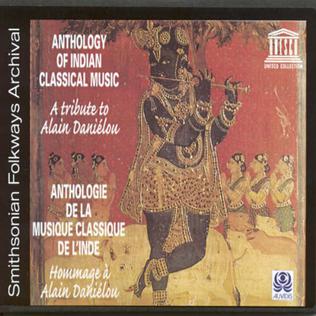 W
WThe Anthology of Indian Classical Music – A Tribute to Alain Daniélou is the 1997 edition of Alain Danielou's Anthology of Indian Classical Music.
 W
WBobbili veena is a large plucked string instrument used in Carnatic classical music. The Veena is named after Bobbili, a place where it was invented. In 2011 the musical instrument got a Geographical Indication tag from the Government of India.
 W
WChong Chiu Sen is a Malaysian-born Chinese vocalist. He was an apprentice of Carnatic musician D. K. Pattammal who also adopted him as her god-grandson and named him Sai Madhana Mohan Kumar.
 W
WDhaivat/Dhaivata is the sixth svara from the seven svaras of Hindustani music and Carnatic music. Dhaivata is the long form of the syllable ध. For simplicity in pronouncing while singing the syllable, Dhaivata is pronounced as Dha. It is also called as धैवत in the Devanagri script.
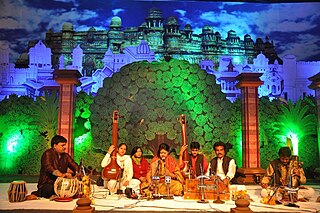 W
WThe following is an incomplete list of Indian classical music festivals, which encapsulates music festivals focused on Indian classical music. The origins of Indian classical music can be found in the Vedas, which are the oldest scriptures in the Hindu tradition dating back to 1500 BC. Indian classical music has also been significantly influenced by, or syncretised with, Indian folk music. There are two divisions in Indian classical music. Hindustani music is mainly found in North India. Carnatic music, from South India, tends to be more rhythmically intensive and structured than Hindustani music. While some festivals such as the Carnatic event Tyagaraja Aradhana continue to focus on traditional Carnatic classical music, an emergent trend of the past few decades has been that of fusion music, where genres such as khyal and western music are intermixed to appeal to a wider audience.
 W
WGeetam, (Sanskrit: गीतं; gītaṃ) the simplest music form in Carnatic music, was created by Purandara Dasa in order to introduce talas with sāhityaṃ (lyrics).
 W
WThe Haridasa devotional movement (sampradaya) originated in Karnataka, India, after Madhvacharya, and spread to eastern states such as Bengal and Assam of medieval India. Over a span of nearly six centuries, several saints and mystics helped shape the culture, philosophy and art of South India in general and Karnataka in particular by exerting considerable spiritual influence over the masses and kingdoms that ruled South India.
 W
WKalakshetra Foundation, formerly simply Kalakshetra, is an arts and cultural academy dedicated to the preservation of traditional values in Indian art and crafts, especially in the field of Bharatanatyam dance and Gandharvaveda music. Based in Chennai, India, the academy was founded in January 1936 by Rukmini Devi Arundale and her husband George Arundale. Under Arundale's guidance, the institution achieved national and international recognition for its unique style and perfectionism. In 1962, Kalakshetra moved to a new campus in Besant Nagar, Chennai, occupying 40 hectares of land.
 W
WKriti is a format of musical composition typical to Carnatic music. Kritis form the mental backbone of any typical Carnatic music concert and is the longer format of Carnatic song. "Kriti" also means Creation.
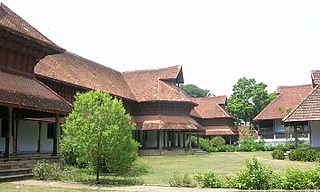 W
WKuthiramalika is a palace built by Swathi Thirunal Rama Varma on the south-eastern side of Padmanabhaswamy temple, Thiruvananthapuram.
 W
WMadhyama/Madhyam is the fourth svara from the seven svaras of Hindustani music and Carnatic music. Madhyama is the long form of the syllable म. For simplicity in pronouncing while singing the syllable, Madhyama is pronounced as Ma. It is also called as मध्यम in the Devanagri script.
 W
WMadras Music Academy is one of the earliest established music academies in South India. Before the concept of infrastructure was introduced to India in the early 1920s, it was a gathering for elite musicians simply called Music Academy It plays an important role in encouraging and promoting primarily the Carnatic Music Indian art form. It played a vital role in the revival of the Indian classical dance form of Bharatnatyam in the 1930s when it faced near extinction due to a negative connotation caused by conservative societal standards.
 W
WChennai Music Season is an event hosted every Mid November–January in Chennai Tamil Nadu. Spanning some 9 weeks, it comprises top-flight professional and amateur musicians. The traditional role of the Music Season is to allow aficionados of Carnatic music to appreciate performances by renowned artists, and to allow promising young artists to display their talent and skill. Audiences and artists come from across India and her diaspora to enjoy the season.
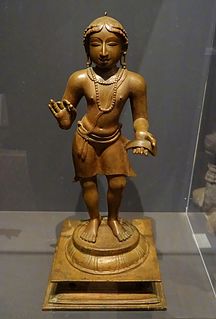 W
WManikkavacakar, or Maanikkavaasagar, was a 9th-century Tamil poet who wrote Tiruvasakam, a book of Shaiva hymns. He was one of the main authors of Saivite Tirumurai, his work forms volume eight of the Tirumurai, the key religious text of Tamil language Shaiva Siddhanta. A minister to the Pandya king Varagunavarman II, he lived in Madurai. His work is a poetic expression of the joy of God-experience, the anguish of being separated from God. Although he is a prominent saint in Southern India, he is not counted among the sixty-three nayanars.
 W
WNiṣāda, also known as Nishada or Nishad, is the seventh svara from the seven svaras of Hindustani music and Carnatic music. Nishada is the long form of the syllable नी. For simplicity in pronouncing while singing the syllable, Nishada is pronounced as Ni. It is also called as निषाद in the Devanagri script.
 W
WA pallavi is the thematic line of a song in carnatic music. It is usually one cycle long and repeated twice in order to give the percussionist the idea of the chosen taalam. Sometimes it is repeated a few more times using different phrases of the Rāgam to which the song is set.
 W
WPanchama/Pancham is the fifth svara from the seven svaras of Hindustani music and Carnatic music. Panchama is the long form of the syllable प. For simplicity in pronouncing while singing the syllable, Panchama is pronounced as Pa. It is also called as पंचम in the Devanagri script.
 W
WṢaḍja/Shadja/Sadja is the first svara from the seven svaras of Hindustani music and Carnatic music. Sadja is the long form of the syllable सा. For simplicity in pronouncing while singing the syllable, Sadja is pronounced as Sa. It is also called as षड्ज in the Devanagri script.
 W
WSangeetha Kalanidhi or Sangita Kalanidhi is the title awarded yearly to a Carnatic musician by the Madras Music Academy.
 W
WThe Sangita-Ratnakara, सङ्गीतरत्नाकर,, literally "Ocean of Music and Dance", is one of the most important Sanskrit musicological texts from India. Composed by Śārṅgadeva (शार्ङ्गदेव) in the 13th century, both Hindustani music and Carnatic music traditions of Indian classical music regard it as a definitive text. The author was a part of the court of King Singhana II (1210–1247) of the Yādava dynasty whose capital was Devagiri, Maharashtra.
 W
WThe Sarasvati vīṇa is an Indian plucked string instrument. It is named after the Hindu goddess Saraswati, who is usually depicted holding or playing the instrument. Also known as raghunatha veena is used mostly in Carnatic Indian classical music. There are several variations of the veena, which in its South Indian form is a member of the lute family. One who plays the veena is referred to as a vainika.
 W
WSri Krishna Leela Tarangini is a tarangini or a Sanskrit opera authored by Narayana Teertha. The songs are in chaste Sanskrit and clear diction and are rich in poetic quality. Tarangini is an opera highly suitable for dance drama and it has been very well utilized by Indian classical dancers over the last two centuries. Tarangini consists of 12 Tarangams and encapsulates 153 songs, 302 slokams and 31 choornikaas. Teertha followed Veda VyAsa’s Bhagavatam and concentrated on the 10th skandam.
 W
WSwathi Sangeethotsavam is a ten-day festival of music celebrating the compositions of Maharaja Swathi Thirunal. The festival is held from 4 to 13 January every year at Kuthira Malika, Trivandrum, where the Maharaja is believed to have composed many of his works. The festival is a tribute to Swathi Tirunal and is exclusively dedicated to his compositions. The concerts are not ticketed. The festival is conducted by Rama Varma Maharaja of Travancore Trust under the helm of Prince Rama Varma.
 W
WThe Thevaram, also spelled Tevaram, denotes the first seven volumes of the twelve-volume collection Tirumurai, a Śaiva narrative of epic and puranic heroes, as well as a hagiographic account of early Saiva saints set in devotional poetry. The Thevaram volumes contain the works of the three most prominent Saiva Tamil poets of the 7th and 8th centuries: Sambandar, Appar, and Sundarar. The three poets were not only involved in portraying their personal devotion to Shiva, but also engaged a community of believers through their songs. Their work is an important source for understanding the Śaiva Bhakti movement in the early medieval South India.
 W
WVarṇam is a type of composition in the Carnatic music system consisting of short metric pieces which encapsulate the main features of a raga. Varnams capture the raga bhavam, ranjaka prayogas visesha sancharas, etc. Dhatu and Janta prayogas are usually part of a Varnam. Understanding of these aspects is key to developing manodharma sangeetham.
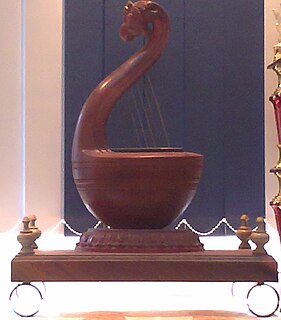 W
WThe yazhal is a harp used in ancient Tamil music. A closely related word yali refers to any structure, particularly front, that resembles the way the tip of stem of this instrument was carved into. The yazh was an open-stringed polyphonous instrument, with gut strings (narambu) with a wooden boat-shaped skin-covered resonator and an ebony stem.